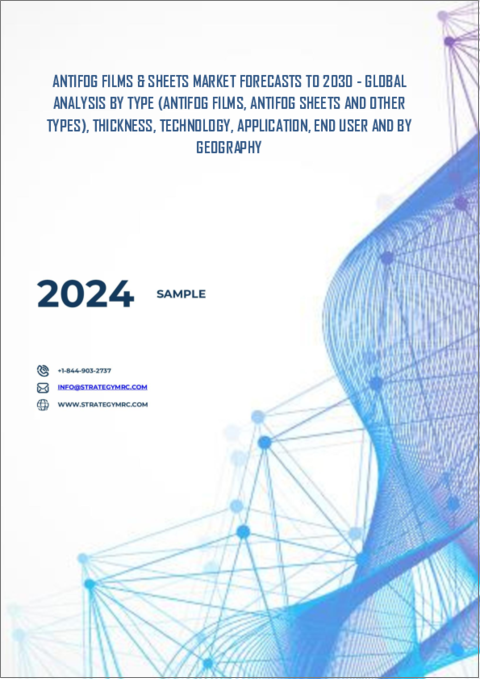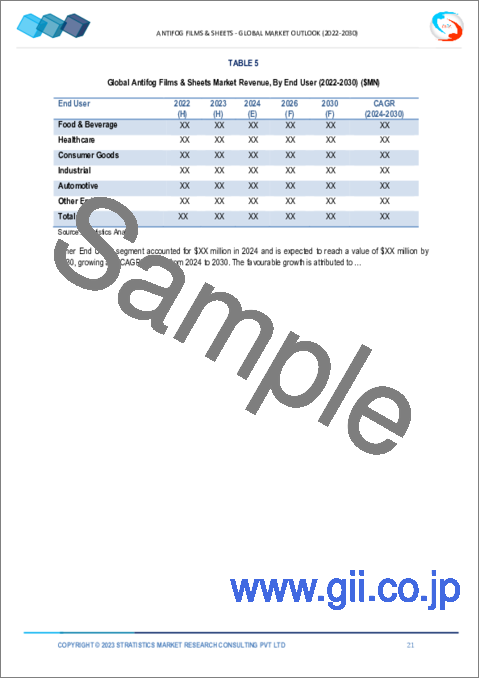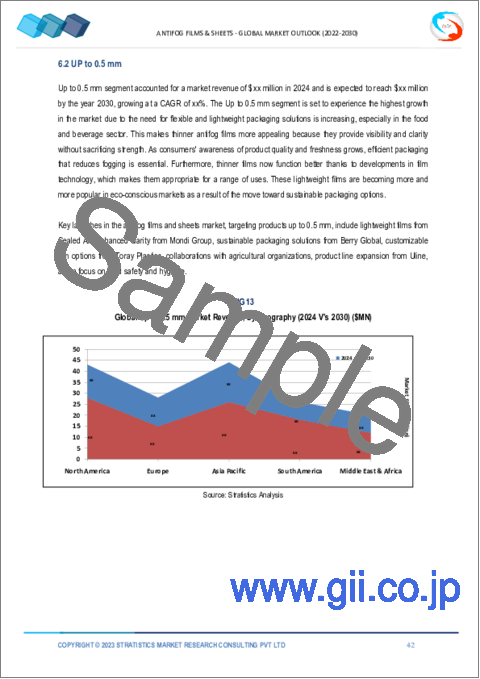|
|
市場調査レポート
商品コード
1558271
防曇フィルム・シート市場の2030年までの予測: タイプ別、厚さ別、技術別、用途別、エンドユーザー別、地域別の世界分析Antifog Films & Sheets Market Forecasts to 2030 - Global Analysis By Type (Antifog Films, Antifog Sheets and Other Types), Thickness, Technology, Application, End User and By Geography |
||||||
カスタマイズ可能
|
|||||||
| 防曇フィルム・シート市場の2030年までの予測: タイプ別、厚さ別、技術別、用途別、エンドユーザー別、地域別の世界分析 |
|
出版日: 2024年09月06日
発行: Stratistics Market Research Consulting
ページ情報: 英文 200+ Pages
納期: 2~3営業日
|
全表示
- 概要
- 図表
- 目次
Stratistics MRCによると、防曇フィルム・シートの世界市場は2024年に39億米ドルを占め、予測期間中のCAGRは7.1%で2030年には59億米ドルに達する見込みです。
防曇フィルム・シートは、表面の結露や曇りを防ぎ、視認性と機能性を高めるために設計された特殊素材です。自動車窓、眼鏡、ディスプレイ画面など、さまざまな製品に一般的に使用されています。これらのフィルムには、水分を管理する親水性または疎水性コーティングが施されており、さまざまな環境条件下でもクリアな視界を確保します。防曇フィルムは、安定した視界を必要とする用途において極めて重要であり、まぶしさや曇りによる見えにくさを軽減することで、安全性と性能を向上させます。
コンビニエンス・フードの需要増加
コンビニエンス・フードの需要の高まりが、食品包装業界の市場成長を牽引しています。これらの材料は、消費者が製品の品質や鮮度を容易に確認できるように、包装食品の視認性を高めるために使用されることが多くなっています。防曇フィルムは、包装上の透明で湿気のない表面を維持するのに役立ち、消費者の全体的な体験を向上させます。コンビニエンス・フードがその使いやすさと迅速な調理で人気を集めるにつれて、包装における効果的な防曇ソリューションの必要性がより重要になっています。
限られた認識と採用
市場における認識と採用が限定的であると、業界内の成長とイノベーションの妨げになることがあります。エンドユーザーやメーカーがこれらの材料の利点や用途を知らない場合、製品の視認性や品質の潜在的な改善を見逃してしまう可能性があります。このような採用不足は、市場拡大の遅れ、研究開発投資の減少、技術進歩率の低下につながる可能性があります。その結果、市場の潜在力は未開拓のままとなり、業界全体の進歩や競合に影響を及ぼすことになります。
高品質包装に対する消費者の嗜好の高まり
消費者は、製品の視認性、鮮度、全体的な見栄えを確保できる包装を求めており、透明で魅力的な包装を維持するために防曇ソリューションが不可欠となっています。これらのフィルムは、表面の曇りや結露を防ぐことで消費者の体験を向上させ、包装された商品の品質と美観を保ちます。高級パッケージングが重視されるようになるにつれ、消費者の期待に応え、製品の魅力を高めるためには、防曇フィルムの採用が不可欠となっています。
高い生産コスト
市場における生産コストの高さは、市場の成長に大きな影響を与える可能性があります。生産コストの上昇は最終消費者の価格上昇につながり、特に価格に敏感なセグメントでは市場導入が制限される可能性があります。この経済的障壁は、メーカーが先端技術やイノベーションへの投資を躊躇させ、手頃な価格のソリューションの開発を遅らせる可能性があります。その結果、市場は停滞に直面し、競争が低下し、進化する消費者ニーズや業界ニーズへの対応が遅れる可能性があります。
COVID-19の影響:
COVID-19の流行は市場にさまざまな影響を与えました。保護的で衛生的なパッケージング・ソリューションに対する需要の高まりにより、特に食品とヘルスケア分野で防曇フィルムの使用が急増しました。サプライチェーンの混乱、製造能力の低下、経済の不確実性は、生産遅延や生産コストの増加など、市場の課題につながりました。全体として、パンデミックは防曇ソリューションの重要性を浮き彫りにする一方で、運用上の大きな障害ももたらしました。
予測期間中、水性熱硬化性コーティング分野が最大となる見込み
予測期間中、水性熱硬化性コーティングが最大となる見込みです。水溶性樹脂をベースとするこれらのコーティング剤は、硬化して耐久性があり、曇りにくい層を形成し、透明性を維持してパッケージングやディスプレイ表面の性能を高める。水溶性樹脂をベースとするこれらのコーティング剤は、溶剤をベースとするコーティング剤に代わる持続可能な代替品を提供し、環境に優しい慣行を実現します。防曇フィルムに応用することで、環境への影響を低減しながら、視認性と製品のプレゼンテーションを向上させ、パッケージングにおける持続可能性への需要の高まりに応えることができます。
消費財セグメントは予測期間中最も高いCAGRが見込まれる
消費財セグメントは、強化されたパッケージング・ソリューションへの需要により、予測期間中に最も高いCAGRが見込まれます。防曇フィルムは、明確な視認性を確保し、製品の鮮度を維持するために、食品やパーソナルケア製品の包装に広く使用されています。これは、品質評価とアピールに不可欠な製品のクリアな視界を可能にすることで、消費者の体験を向上させます。高品質で透明な包装に対する消費者の期待が高まるにつれ、消費財における防曇フィルムの使用は拡大し続けています。
最大のシェアを占める地域
予測期間中、北米が最大の市場シェアを占めると予測されています。飲食品、医薬品、パーソナルケアなどの主要セクターは、製品の視認性を高め、鮮度を確保するために防曇フィルムを採用しています。この市場を支えているのは、フィルム技術の先進化と、透明で魅力的なパッケージに対する消費者の期待の高まりです。さらに、厳しい規制基準と持続可能性への注目が、この地域における防曇ソリューションの採用をさらに後押ししています。
CAGRが最も高い地域:
アジア太平洋地域は予測期間中最も高いCAGRを維持すると予測されています。製品の視認性と訴求力を維持するための透明包装の需要は、特にコンビニエンス食品分野で増加しています。食品の安全性や衛生基準に関する意識の高まりが、食品や医療用包装における防曇フィルムの採用を促進しています。生産技術の絶え間ない進歩により、高性能の防曇フィルムが開発され、その効果と応用範囲が拡大しています。
無料のカスタマイズサービス
本レポートをご購読のお客様には、以下の無料カスタマイズオプションのいずれかをご利用いただけます:
- 企業プロファイル
- 追加市場プレイヤーの包括的プロファイリング(3社まで)
- 主要企業のSWOT分析(3社まで)
- 地域セグメンテーション
- 顧客の関心に応じた主要国の市場推計・予測・CAGR(注:フィージビリティチェックによる)
- 競合ベンチマーキング
- 製品ポートフォリオ、地理的プレゼンス、戦略的提携に基づく主要企業のベンチマーキング
目次
第1章 エグゼクティブサマリー
第2章 序文
- 概要
- ステークホルダー
- 調査範囲
- 調査手法
- データマイニング
- データ分析
- データ検証
- 調査アプローチ
- 調査情報源
- 1次調査情報源
- 2次調査情報源
- 前提条件
第3章 市場動向分析
- 促進要因
- 抑制要因
- 機会
- 脅威
- 技術分析
- 用途分析
- エンドユーザー分析
- 新興市場
- COVID-19の影響
第4章 ポーターのファイブフォース分析
- 供給企業の交渉力
- 買い手の交渉力
- 代替品の脅威
- 新規参入業者の脅威
- 競争企業間の敵対関係
第5章 世界の防曇フィルム・シート市場:タイプ別
- 防曇フィルム
- ストレッチフィルム
- シュリンクフィルム
- 防曇シート
- ポリカーボネートシート
- ポリエステルシート
- ポリプロピレンシート
- その他のタイプ
第6章 世界の防曇フィルム・シート市場:厚さ別
- 最大0.5mm
- 0.5mm~2mm
- 2mm~5mm
- 5mm~7mm
- 7mm以上
第7章 世界の防曇フィルム・シート市場:技術別
- 練り界面活性剤
- 水性熱硬化性コーティング
- 光触媒コーティング
- UVコーティング
- その他の技術
第8章 世界の防曇フィルム・シート市場:用途別
- ディスプレイ
- 医療機器
- 工業用バイザーとゴーグル
- ミラー
- 窓とフロントガラス
- ソーラーパネル
- その他の用途
第9章 世界の防曇フィルム・シート市場:エンドユーザー別
- 飲食品
- ヘルスケア
- 消費財
- 産業
- 自動車
- その他のエンドユーザー
第10章 世界の防曇フィルム・シート市場:地域別
- 北米
- 米国
- カナダ
- メキシコ
- 欧州
- ドイツ
- 英国
- イタリア
- フランス
- スペイン
- その他欧州
- アジア太平洋
- 日本
- 中国
- インド
- オーストラリア
- ニュージーランド
- 韓国
- その他アジア太平洋地域
- 南米
- アルゼンチン
- ブラジル
- チリ
- その他南米
- 中東・アフリカ
- サウジアラビア
- アラブ首長国連邦
- カタール
- 南アフリカ
- その他中東とアフリカ
第11章 主な発展
- 契約、パートナーシップ、コラボレーション、合弁事業
- 買収と合併
- 新製品発売
- 事業拡大
- その他の主要戦略
第12章 企業プロファイリング
- 3M Company
- Berry Global, Inc.
- Tredegar Corporation
- Fujifilm Holdings Corporation
- Eastman Chemical Company
- Saint-Gobain S.A.
- Avery Dennison Corporation
- Mitsubishi Chemical Corporation
- Kuraray Co., Ltd.
- Polyone Corporation
- Toray Industries, Inc.
- SABIC
- Lotte Chemical Corporation
- Jindal Poly Films Ltd.
- Sealed Air Corporation
- Polyonics, Inc.
List of Tables
- Table 1 Global Antifog Films & Sheets Market Outlook, By Region (2022-2030) ($MN)
- Table 2 Global Antifog Films & Sheets Market Outlook, By Type (2022-2030) ($MN)
- Table 3 Global Antifog Films & Sheets Market Outlook, By Antifog Films (2022-2030) ($MN)
- Table 4 Global Antifog Films & Sheets Market Outlook, By Stretch Films (2022-2030) ($MN)
- Table 5 Global Antifog Films & Sheets Market Outlook, By Shrink Films (2022-2030) ($MN)
- Table 6 Global Antifog Films & Sheets Market Outlook, By Antifog Sheets (2022-2030) ($MN)
- Table 7 Global Antifog Films & Sheets Market Outlook, By Polycarbonate Sheets (2022-2030) ($MN)
- Table 8 Global Antifog Films & Sheets Market Outlook, By Polyester Sheets (2022-2030) ($MN)
- Table 9 Global Antifog Films & Sheets Market Outlook, By Polypropylene Sheets (2022-2030) ($MN)
- Table 10 Global Antifog Films & Sheets Market Outlook, By Other Types (2022-2030) ($MN)
- Table 11 Global Antifog Films & Sheets Market Outlook, By Thickness (2022-2030) ($MN)
- Table 12 Global Antifog Films & Sheets Market Outlook, By Up to 0.5 mm (2022-2030) ($MN)
- Table 13 Global Antifog Films & Sheets Market Outlook, By 0.5 mm to 2 mm (2022-2030) ($MN)
- Table 14 Global Antifog Films & Sheets Market Outlook, By 2 mm to 5 mm (2022-2030) ($MN)
- Table 15 Global Antifog Films & Sheets Market Outlook, By 5 mm to 7 mm (2022-2030) ($MN)
- Table 16 Global Antifog Films & Sheets Market Outlook, By Above 7 mm (2022-2030) ($MN)
- Table 17 Global Antifog Films & Sheets Market Outlook, By Technology (2022-2030) ($MN)
- Table 18 Global Antifog Films & Sheets Market Outlook, By Kneading Surfactant (2022-2030) ($MN)
- Table 19 Global Antifog Films & Sheets Market Outlook, By Aqueous Thermosetting Coating (2022-2030) ($MN)
- Table 20 Global Antifog Films & Sheets Market Outlook, By Photocatalyst Coating (2022-2030) ($MN)
- Table 21 Global Antifog Films & Sheets Market Outlook, By UV Coatings (2022-2030) ($MN)
- Table 22 Global Antifog Films & Sheets Market Outlook, By Other Technologies (2022-2030) ($MN)
- Table 23 Global Antifog Films & Sheets Market Outlook, By Application (2022-2030) ($MN)
- Table 24 Global Antifog Films & Sheets Market Outlook, By Displays (2022-2030) ($MN)
- Table 25 Global Antifog Films & Sheets Market Outlook, By Medical Devices (2022-2030) ($MN)
- Table 26 Global Antifog Films & Sheets Market Outlook, By Industrial Visors & Goggles (2022-2030) ($MN)
- Table 27 Global Antifog Films & Sheets Market Outlook, By Mirrors (2022-2030) ($MN)
- Table 28 Global Antifog Films & Sheets Market Outlook, By Windows and Windshields (2022-2030) ($MN)
- Table 29 Global Antifog Films & Sheets Market Outlook, By Solar Panels (2022-2030) ($MN)
- Table 30 Global Antifog Films & Sheets Market Outlook, By Other Applications (2022-2030) ($MN)
- Table 31 Global Antifog Films & Sheets Market Outlook, By End User (2022-2030) ($MN)
- Table 32 Global Antifog Films & Sheets Market Outlook, By Food & Beverage (2022-2030) ($MN)
- Table 33 Global Antifog Films & Sheets Market Outlook, By Healthcare (2022-2030) ($MN)
- Table 34 Global Antifog Films & Sheets Market Outlook, By Consumer Goods (2022-2030) ($MN)
- Table 35 Global Antifog Films & Sheets Market Outlook, By Industrial (2022-2030) ($MN)
- Table 36 Global Antifog Films & Sheets Market Outlook, By Automotive (2022-2030) ($MN)
- Table 37 Global Antifog Films & Sheets Market Outlook, By Other End Users (2022-2030) ($MN)
Note: Tables for North America, Europe, APAC, South America, and Middle East & Africa Regions are also represented in the same manner as above.
According to Stratistics MRC, the Global Antifog Films & Sheets Market is accounted for $3.9 billion in 2024 and is expected to reach $5.9 billion by 2030 growing at a CAGR of 7.1% during the forecast period. Antifog films and sheets are specialized materials designed to prevent condensation and fogging on surfaces, enhancing visibility and functionality. They are commonly applied to various products, including automotive windows, eyewear, and display screens. These films incorporate hydrophilic or hydrophobic coatings that manage moisture, ensuring a clear view under varying environmental conditions. Antifog films are crucial in applications requiring consistent visibility, improving safety and performance by reducing glare and obscuring effects caused by fogging.
Market Dynamics:
Driver:
Rising demand for convenience foods
The rising demand for convenience foods is driving the growth of the market in the food packaging industry. These materials are increasingly used to enhance the visibility of packaged foods, ensuring that consumers can easily view product quality and freshness. Antifog films help maintain a clear, moisture-free surface on packaging, improving the overall consumer experience. As convenience foods gain popularity for their ease of use and quick preparation, the need for effective antifog solutions in packaging becomes more critical.
Restraint:
Limited awareness and adoption
Limited awareness and adoption in the market can hinder growth and innovation within the industry. When end-users and manufacturers are unaware of the benefits or applications of these materials, they may miss out on potential improvements in product visibility and quality. This lack of adoption can lead to slower market expansion, reduced investments in research and development, and a lower rate of technological advancement. Consequently, the market's potential remains underexploited, affecting overall industry progress and competitiveness.
Opportunity:
Increased consumer preference for high-quality packaging
Consumers are seeking packaging that ensures product visibility, freshness, and overall presentation, making antifog solutions essential for maintaining clear and appealing packaging. These films enhance the consumer experience by preventing fogging and condensation on surfaces, thus preserving the quality and aesthetic of packaged goods. As the emphasis on premium packaging grows, the adoption of antifog films becomes crucial for meeting consumer expectations and enhancing product appeal.
Threat:
High cost of production
The high cost of production in the market can significantly impact market growth. Elevated production costs can lead to higher prices for end consumers, potentially limiting market adoption, especially in price-sensitive segments. This financial barrier may deter manufacturers from investing in advanced technologies and innovations, slowing the development of affordable solutions. Consequently, the market could face stagnation, with reduced competition and slower progress in meeting evolving consumer and industry needs.
Covid-19 Impact:
The COVID-19 pandemic has had a mixed impact on the market. Increased demand for protective and hygienic packaging solutions led to a surge in the use of antifog films, particularly in food and healthcare sectors. Disruptions in supply chains, reduced manufacturing capacities, and economic uncertainties led to market challenges, including delays and increased production costs. Overall, while the pandemic highlighted the importance of antifog solutions, it also introduced significant operational hurdles.
The aqueous thermosetting coating segment is expected to be the largest during the forecast period
The aqueous thermosetting coating is expected to be the largest during the forecast period. These coatings, based on water-soluble resins, cure to form a durable, fog-resistant layer that maintains clarity and enhances the performance of packaging and display surfaces. They offer a sustainable alternative to solvent-based coatings, aligning with eco-friendly practices. Their application in antifog films improves visibility and product presentation while reducing environmental impact, catering to growing demands for sustainability in packaging.
The consumer goods segment is expected to have the highest CAGR during the forecast period
The consumer goods segment is expected to have the highest CAGR during the forecast period due to their demand for enhanced packaging solutions. Antifog films are widely used in packaging for food and personal care products to ensure clear visibility and maintain product freshness. This improves consumer experience by allowing a clear view of the product, which is crucial for quality assessment and appeal. As consumer expectations for high-quality and transparent packaging grow, the use of antifog films in consumer goods continues to expand.
Region with largest share:
North America is projected to hold the largest market share during the forecast period. Key sectors such as food and beverages, pharmaceuticals, and personal care are adopting antifog films to enhance product visibility and ensure freshness. The market is supported by advancements in film technologies and rising consumer expectations for transparent and attractive packaging. Additionally, stringent regulatory standards and a focus on sustainability are further propelling the adoption of antifog solutions in the region.
Region with highest CAGR:
Asia Pacific is projected to hold the highest CAGR over the forecast period. The demand for clear packaging to maintain product visibility and appeal is increasing, particularly in the convenience food sector. Increased awareness regarding food safety and hygiene standards is driving the adoption of antifog films in food and medical packaging. Continuous advancements in production technologies are leading to the development of high-performance antifog films, enhancing their effectiveness and application range.
Key players in the market
Some of the key players in Antifog Films & Sheets market include 3M Company, Berry Global, Inc., Tredegar Corporation, Fujifilm Holdings Corporation, Eastman Chemical Company, Saint-Gobain S.A., Avery Dennison Corporation, Mitsubishi Chemical Corporation, Kuraray Co., Ltd., Polyone Corporation, Toray Industries, Inc., SABIC, Lotte Chemical Corporation, Jindal Poly Films Ltd., Sealed Air Corporation and Polyonics, Inc.
Key Developments:
In April 2024, Berry Global released paper detailing an alternative to PVC cling films. The solution to finding an alternative to traditional polyvinyl chloride (PVC) cling films for fresh food applications is outlined in a new White Paper from Berry Global.
In November 2023, Berry Global introduced a highly efficient version of its polyethylene cling film called Omni Xtra, which is designed for use in fresh food applications. This new cling film is a superior alternative to conventional polyvinyl chloride (PVC) cling films.
Types Covered:
- Antifog Films
- Antifog Sheets
- Other Types
Thickness Covered:
- Up to 0.5 mm
- 0.5 mm to 2 mm
- 2 mm to 5 mm
- 5 mm to 7 mm
- Above 7 mm
Technologies Covered:
- Kneading Surfactant
- Aqueous Thermosetting Coating
- Photocatalyst Coating
- UV Coatings
- Other Technologies
Applications Covered:
- Displays
- Medical Devices
- Industrial Visors & Goggles
- Mirrors
- Windows and Windshields
- Solar Panels
- Other Applications
End Users Covered:
- Food & Beverage
- Healthcare
- Consumer Goods
- Industrial
- Automotive
- Other End Users
Regions Covered:
- North America
- US
- Canada
- Mexico
- Europe
- Germany
- UK
- Italy
- France
- Spain
- Rest of Europe
- Asia Pacific
- Japan
- China
- India
- Australia
- New Zealand
- South Korea
- Rest of Asia Pacific
- South America
- Argentina
- Brazil
- Chile
- Rest of South America
- Middle East & Africa
- Saudi Arabia
- UAE
- Qatar
- South Africa
- Rest of Middle East & Africa
What our report offers:
- Market share assessments for the regional and country-level segments
- Strategic recommendations for the new entrants
- Covers Market data for the years 2022, 2023, 2024, 2026, and 2030
- Market Trends (Drivers, Constraints, Opportunities, Threats, Challenges, Investment Opportunities, and recommendations)
- Strategic recommendations in key business segments based on the market estimations
- Competitive landscaping mapping the key common trends
- Company profiling with detailed strategies, financials, and recent developments
- Supply chain trends mapping the latest technological advancements
Free Customization Offerings:
All the customers of this report will be entitled to receive one of the following free customization options:
- Company Profiling
- Comprehensive profiling of additional market players (up to 3)
- SWOT Analysis of key players (up to 3)
- Regional Segmentation
- Market estimations, Forecasts and CAGR of any prominent country as per the client's interest (Note: Depends on feasibility check)
- Competitive Benchmarking
- Benchmarking of key players based on product portfolio, geographical presence, and strategic alliances
Table of Contents
1 Executive Summary
2 Preface
- 2.1 Abstract
- 2.2 Stake Holders
- 2.3 Research Scope
- 2.4 Research Methodology
- 2.4.1 Data Mining
- 2.4.2 Data Analysis
- 2.4.3 Data Validation
- 2.4.4 Research Approach
- 2.5 Research Sources
- 2.5.1 Primary Research Sources
- 2.5.2 Secondary Research Sources
- 2.5.3 Assumptions
3 Market Trend Analysis
- 3.1 Introduction
- 3.2 Drivers
- 3.3 Restraints
- 3.4 Opportunities
- 3.5 Threats
- 3.6 Technology Analysis
- 3.7 Application Analysis
- 3.8 End User Analysis
- 3.9 Emerging Markets
- 3.10 Impact of Covid-19
4 Porters Five Force Analysis
- 4.1 Bargaining power of suppliers
- 4.2 Bargaining power of buyers
- 4.3 Threat of substitutes
- 4.4 Threat of new entrants
- 4.5 Competitive rivalry
5 Global Antifog Films & Sheets Market, By Type
- 5.1 Introduction
- 5.2 Antifog Films
- 5.2.1 Stretch Films
- 5.2.2 Shrink Films
- 5.3 Antifog Sheets
- 5.3.1 Polycarbonate Sheets
- 5.3.2 Polyester Sheets
- 5.3.3 Polypropylene Sheets
- 5.4 Other Types
6 Global Antifog Films & Sheets Market, By Thickness
- 6.1 Introduction
- 6.2 Up to 0.5 mm
- 6.3 0.5 mm to 2 mm
- 6.4 2 mm to 5 mm
- 6.5 5 mm to 7 mm
- 6.6 Above 7 mm
7 Global Antifog Films & Sheets Market, By Technology
- 7.1 Introduction
- 7.2 Kneading Surfactant
- 7.3 Aqueous Thermosetting Coating
- 7.4 Photocatalyst Coating
- 7.5 UV Coatings
- 7.6 Other Technologies
8 Global Antifog Films & Sheets Market, By Application
- 8.1 Introduction
- 8.2 Displays
- 8.3 Medical Devices
- 8.4 Industrial Visors & Goggles
- 8.5 Mirrors
- 8.6 Windows and Windshields
- 8.7 Solar Panels
- 8.8 Other Applications
9 Global Antifog Films & Sheets Market, By End User
- 9.1 Introduction
- 9.2 Food & Beverage
- 9.3 Healthcare
- 9.4 Consumer Goods
- 9.5 Industrial
- 9.6 Automotive
- 9.7 Other End Users
10 Global Antifog Films & Sheets Market, By Geography
- 10.1 Introduction
- 10.2 North America
- 10.2.1 US
- 10.2.2 Canada
- 10.2.3 Mexico
- 10.3 Europe
- 10.3.1 Germany
- 10.3.2 UK
- 10.3.3 Italy
- 10.3.4 France
- 10.3.5 Spain
- 10.3.6 Rest of Europe
- 10.4 Asia Pacific
- 10.4.1 Japan
- 10.4.2 China
- 10.4.3 India
- 10.4.4 Australia
- 10.4.5 New Zealand
- 10.4.6 South Korea
- 10.4.7 Rest of Asia Pacific
- 10.5 South America
- 10.5.1 Argentina
- 10.5.2 Brazil
- 10.5.3 Chile
- 10.5.4 Rest of South America
- 10.6 Middle East & Africa
- 10.6.1 Saudi Arabia
- 10.6.2 UAE
- 10.6.3 Qatar
- 10.6.4 South Africa
- 10.6.5 Rest of Middle East & Africa
11 Key Developments
- 11.1 Agreements, Partnerships, Collaborations and Joint Ventures
- 11.2 Acquisitions & Mergers
- 11.3 New Product Launch
- 11.4 Expansions
- 11.5 Other Key Strategies
12 Company Profiling
- 12.1 3M Company
- 12.2 Berry Global, Inc.
- 12.3 Tredegar Corporation
- 12.4 Fujifilm Holdings Corporation
- 12.5 Eastman Chemical Company
- 12.6 Saint-Gobain S.A.
- 12.7 Avery Dennison Corporation
- 12.8 Mitsubishi Chemical Corporation
- 12.9 Kuraray Co., Ltd.
- 12.10 Polyone Corporation
- 12.11 Toray Industries, Inc.
- 12.12 SABIC
- 12.13 Lotte Chemical Corporation
- 12.14 Jindal Poly Films Ltd.
- 12.15 Sealed Air Corporation
- 12.16 Polyonics, Inc.






